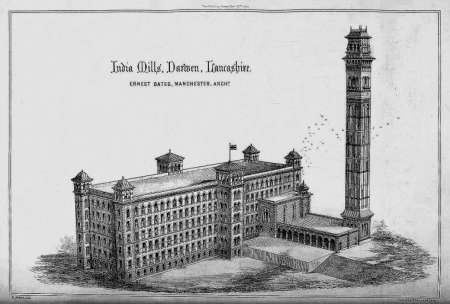India Mill, Darwen
This building, of which we give an illustration, is the one in which the art exhibition of August last, was held, and presents several noteworthy features, one of these being the largest, if not the highest, chimney shaft in the world. The mill itself is 330 feet long, 99 feet wide, 90 feet high, and contains six stories. The engine house is 80 feet by 28ft, the engine bed containing 20,000 ft. of ashlar. The boiler house is 100 feet by 75 feet, and accommodates ten boilers. There ia also a cotton shed and twist warehouse 100 feet by 80 feet. The engineering and mill gearing is being executed by the trustees of the late W and J Yates, of Blackburn, all the entablatures and pillars being carefully got out to architectural proportions, an unusual thing in machinery. The total height of the chimney shaft from the bottom of the foundations to the top of the iron cresting is 310.5 feet, and from the ground line 300 feet. The base is of solid ashlar, 29 feet square at ground line, and 42ft. high. The massive stone cornice lo the base is 35 feet long on each of the four sides. The shaft itself is built with red, white, and black bricks, with sand gritstone dressings, and is 24 feet square, and built perfectly plumb. The walls are 3feet thick at top of stone base, reduced by "set-offs " on the inside to 23inches. at the commencement of main cornice, which is 255 feet above the ground. Many of the stones used in this cornice weighed as much as five tons each, and were hoisted by steam power. Tho balusters surmounting this feature are of cast iron, as also are portions of the four vases at the corners. The crown mould of the cornice at the top of the shaft projects more than three times as far over the wall as it rests on it, and was kept in its place by iron cramps until the cast iron cresting was fixed upon it. This cresting contains about 20 tons of metal, and is composed of more than three hundred castings. There is no bolting nor any particle of wrought iron in this portion of the work, the parts being kept together by slots and lugs. The whole weight of this cresting stands upon the brickwork, and keeps the upper stone cornice firmly in position. There is an interior and totally independent shaft, 180 feet high, to prevent the great heat from the boiler furnaces subjecting the wall of the outer and main shaft to unequal expansion and contraction. Mr. Ernest Bates, of Manchester, is the architect, and the whole of the work has been done by day work by workmen under the superintendence of Mr Robert Edwards, clerk of the works, no Contractor being employed. [Building News 27 November 1868 page 806]
Eccles Shorrock, Brother & Company appear to have been ruined by the costs of the mill and the effects of the Cotton Famine, and in 1874 the India Mills Cotton Spinning Company Limited was formed to purchase, and complete and the mill. The promoters were Eccles Shorrock (Ashton), Richard Eccles of Lower Darwen Mills, William Snape C.& J G.Potter, Joseph Shorrock and Joseph Eccles, Darwen manufacturer.
Reference Building News 27 November 1868 page 806 and illustration
